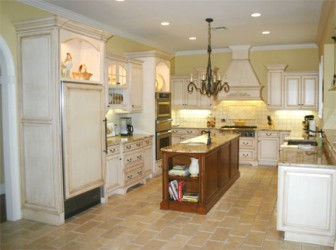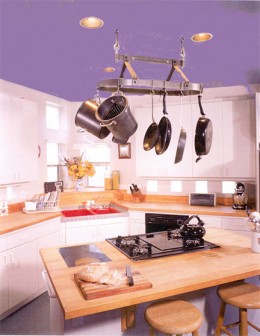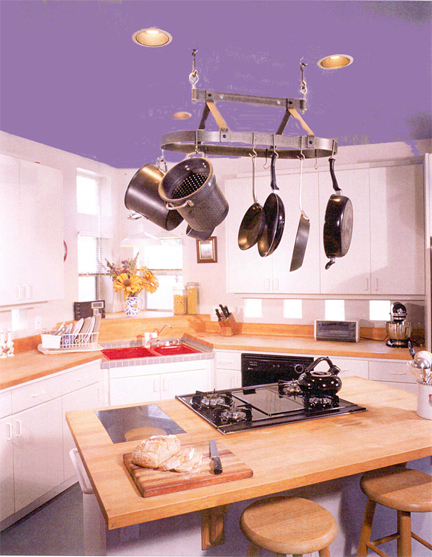The traditional French kitchen is provincial by demand. Design history in general bears out the fact that the monarchs and nobility were the design pacesetters and that in most any century, the commoners followed suit by interpreting those designs through the means and supplies at hand. Hence, the provincial French kitchen bears the mark of agrarian interpretation also. Visualize a kitchen where cheese is made, meat is roughly handled and breezy curtains adorn any window and door. The French kitchen also evokes the smell of fresh bread and earthy colours.
The French are known for their love of food. This has been true always, including at home on the farm of the French countryside. Outfit the kitchen with a butcher block. Though this item was once considered essential in most kitchens it fell out of favour with wall counter space and smaller kitchens. The butcher block requires special care though. Avoid actually processing raw meat on the teak oiled surface for health’s sake. Rather process food on a glass board outfitted on top of the butcher block.
 Whereas in the palaces of yore the kitchens were outfitted with metals and excellent wood cabinetry, the provincial French kitchen sufficed with simpler cabinets. Though some cabinets were stained wood, the general rule was to whitewash the surface. The whitewash was a cheap substitute for expensive veneer work and looked cheerful. And while the French kitchen may have a reputation for the preparation of exotic foods – even in the country, it also has a longstanding reputation for being a place of total enjoyment. Decoratively the provincials achieved this through the whitewash of their cabinetry.
Whereas in the palaces of yore the kitchens were outfitted with metals and excellent wood cabinetry, the provincial French kitchen sufficed with simpler cabinets. Though some cabinets were stained wood, the general rule was to whitewash the surface. The whitewash was a cheap substitute for expensive veneer work and looked cheerful. And while the French kitchen may have a reputation for the preparation of exotic foods – even in the country, it also has a longstanding reputation for being a place of total enjoyment. Decoratively the provincials achieved this through the whitewash of their cabinetry.
The French countryside is dotted with farmhouses. Many of those houses have a secondary entrance right into the kitchen. That entry door is often solid wood with a glass and mullion arrangement on the top half of the door. The windows and the door share a common theme of light, breezy simple window dressings. Select a white cotton pique with a low thread count and mount the curtain on a single flat rod. Avoid fabrics with an overly complicated or fancy pattern. These were reserved for the French city.
Neutrals find inspiration in the environment, with warm hues inspired by organic fibres, natural wood and weathered stone. Red takes on a hint of orange. Yellows are more golden. Greens and blues reflect the beauty of natural aging and are more mellow than vibrant. Colour is an important element in French country design, draw inspiration from some of the principle French impressionists like Monet and Renoir.
 Draw the family and a French country kitchen together around a big natural wood farmhouse table. Consider benches rather than chairs.
Draw the family and a French country kitchen together around a big natural wood farmhouse table. Consider benches rather than chairs.
Use tile, urns and hand painted ceramics extensively in French country kitchens.
Display ceramic tiles and terracotta pieces whenever and wherever possible. Copper pots hung over an island are a wonderful accessory for a French kitchen.
To bring a touch of nature into the French country kitchen, consider hanging a plant or assemble a small herb window garden to keep nearby for cooking. (eHow)










